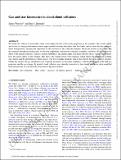Files in this item
Gas and star kinematics in cloud-cloud collisions
Item metadata
| dc.contributor.author | Wurster, James | |
| dc.contributor.author | Bonnell, Ian A | |
| dc.date.accessioned | 2023-04-07T14:30:07Z | |
| dc.date.available | 2023-04-07T14:30:07Z | |
| dc.date.issued | 2023-06-01 | |
| dc.identifier | 284013463 | |
| dc.identifier | 673b645e-d20b-4624-b1b3-2448732831cd | |
| dc.identifier | 85160416931 | |
| dc.identifier.citation | Wurster , J & Bonnell , I A 2023 , ' Gas and star kinematics in cloud-cloud collisions ' , Monthly Notices of the Royal Astronomical Society , vol. 522 , no. 1 , stad1022 , pp. 891-911 . https://doi.org/10.1093/mnras/stad1022 | en |
| dc.identifier.issn | 0035-8711 | |
| dc.identifier.other | Bibtex: 10.1093/mnras/stad1022 | |
| dc.identifier.uri | https://hdl.handle.net/10023/27365 | |
| dc.description | Funding: JW and IAB acknowledge support from the University of St Andrews. The equipment was funded by BEIS capital funding via STFC capital grants ST/K000373/1 and ST/R002363/1 and STFC DiRAC Operations grant ST/R001014/1. | en |
| dc.description.abstract | We model the collision of molecular clouds to investigate the role of the initial properties on the remnants. Our clouds collide and evolve in a background medium that is approximately ten times less dense than the clouds, and we show that this relatively dense background is dynamically important for the evolution of the collision remnants. Given the motion of the clouds and the remnants through the background, we develop, implement, and introduce dynamic boundary conditions. We investigate the effect of the initial cloud mass, velocity, internal turbulence, and impact angle. The initial velocity and its velocity components have the largest affect on the remnant. This affects the spatial extent of the remnant, which affects the number of resulting star clusters and the distribution of their masses. The less extended remnants tend to have fewer, but more massive, clusters. Unlike the clusters, the gas distributions are relatively insensitive to the initial conditions, both the distribution of the bulk gas properties and the gas clumps. In general, cloud collisions are relatively insensitive to their initial conditions when modelled hydrodynamically in a dynamically important background medium. | |
| dc.format.extent | 21 | |
| dc.format.extent | 8727340 | |
| dc.language.iso | eng | |
| dc.relation.ispartof | Monthly Notices of the Royal Astronomical Society | en |
| dc.subject | Stars: formation | en |
| dc.subject | ISM: clouds | en |
| dc.subject | Galaxies: star clusters: general | en |
| dc.subject | Methods: numerical | en |
| dc.subject | QB Astronomy | en |
| dc.subject | QC Physics | en |
| dc.subject | NDAS | en |
| dc.subject | MCC | en |
| dc.subject.lcc | QB | en |
| dc.subject.lcc | QC | en |
| dc.title | Gas and star kinematics in cloud-cloud collisions | en |
| dc.type | Journal article | en |
| dc.contributor.institution | University of St Andrews. School of Physics and Astronomy | en |
| dc.contributor.institution | University of St Andrews. Sir James Mackenzie Institute for Early Diagnosis | en |
| dc.identifier.doi | 10.1093/mnras/stad1022 | |
| dc.description.status | Peer reviewed | en |
This item appears in the following Collection(s)
Items in the St Andrews Research Repository are protected by copyright, with all rights reserved, unless otherwise indicated.

